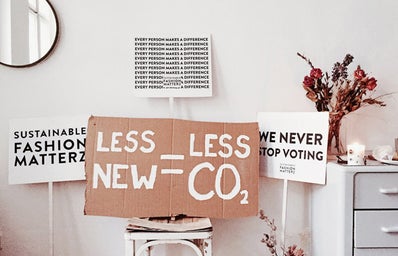In the UK, 11 million pieces of garment land in landfills each week. On top of that, the textile industry contributes more to climate change than international aviation and maritime shipping combined (1). For retail stores and online brands, it is often cheaper to throw away clothes that they couldn’t sell or that were returned instead of recycling and reselling them. Due to this, it is estimated that the global textile industry has an annual carbon footprint of 3.3 billion tonnes of CO2e. That’s close to the emissions of all 28 current EU members combined (3.5 billion tonnes per year) (2). If you are fighting against climate change, you must fight for a change in the fashion industry too. As I found it to be quite overwhelming when I started educating myself on the textile industry, due to the abundance of information, I have created a little 5-step guide on how to transform your closet so it matches your values. I have intentionally created the list from most accessible- low-cost, low-effort, suitable for most abilities and body sizes – to least accessible or simply alternative, less researched options that are still tangible actions you can take.
- @chicksforclimate on instagram
-
1. It starts with YOU
The first step to a more sustainable wardrobe begins in your head. Once you really start to consciously think about and question your shopping habits, things change. Instead of wondering “Do I really want this?”, ask yourself more specific questions like ‘Will I wear this more than 30 times? Do I already own something similar to this?’. Asking yourself more specific and open questions will make it a lot harder for you to convince yourself that you really need this new piece of garment.
Following this change of mindset, you can start sorting out the clothes that you already own. Open your closet and look at your clothes. Take all the time you need to really hold every piece of garment you own and decide which ones you actually would like to keep and which ones you are ready to bid farewell to. I personally do this about once a year. Making three different piles can help you decide which one to keep, maybe keep and not keep. The ‘maybe keep’ pile I would look through once again and ask myself ‘was the last time I wore this more than 3 months ago?’ and ‘will I really wear this 10 more times?’. If the answer to both is ‘no’, it will definitely go onto the ‘goodbye’ pile.
2. And then there are the people around you
Now that you have your ‘goodbye’ pile, it’s time to decide whether you want to donate or sell them. If you want to sell them, there are plenty of ways to do so. Posting and selling your clothes through Instagram is the fastest and most sustainable option. You can also ask your friends, family and acquaintances directly if they are interested in buying some clothes off you. You could sell them at a flea market or organize your own flea market. Get your friends to make their own ‘goodbye’ pile and get together for a clothes swap/sale! (With social distancing in mind, of course).
3. Buy small and buy local
If you do find yourself wanting to buy new clothes, try to look for local options. Living in London has the advantage of having a myriad of small businesses that sell everything and even more than what you can find at big retailers. However, it is often more expensive to buy a locally sourced and made cotton tee than buying the same shirt from Primark that was made in Bangladesh. No one should be ashamed or be judged for their financial situation; we all do our best within our own capabilities. But for those who do have the financial means to buy small and local, try to opt for it as often as possible. Even though you could buy the same shirt at Primark for a fraction of the price, you should again question if it is really worth it. If you intend to wear it over several years, is it not smarter to invest in something that is initially pricier but will most likely last you longer? Not only is it often better quality but you also pay the artist/designer or business owner directly. Look for pages like @asouthlondonmakersmarket that regularly give exposure to small, local businesses in London that you can support. Especially in these uncertain times, your investment in small and local businesses is more important than ever.
4. DIY
With universities closed for in-person teaching and pubs shutting at curfew, we are spending more time indoors than ever. What a great time to learn how to sew your own clothes! You have had that old shirt for years and there’s just something missing that would make you want to keep it? Learn how to rework it by giving it a cute tie-dye, using the material to make something else or even adding fabric to it to make it a complete new piece of clothing. The possibilities are endless once you let your creativity run free. If you dare to, you could even learn how to design and make your own clothes from scratch. There are thousands of YouTube tutorials and online courses you could learn a sewing 101 from.
5. Support your local tailor, buy tailor made clothes. AKA feel like a princess
If you’re like me, an unskilled and hopeless seamstress that still values the quality and craft of a handmade garment, you might want to look into having your clothes tailor-made. It doesn’t have to be completely from scratch; maybe there is a dress you’ve always had a different vision for? Or some pants that would look really cute if they were just a bit shorter and tighter? Bring it to your local tailoring shop, they will be more than happy to help you. Another sustainable option that is recently gaining more mainstream attention is the emergence of handmade-to-order brands. They have pre-made designs that you can choose from; once you order them you can give them your custom sizing and they make them as they are ordered, creating virtually zero waste as the supply never exceeds the demand. Some of the pioneers who are changing the fashion industry right now are @maisoncleo, @oliviarosethelabel and @beforejuly. Their clothes are a bit on the pricier side but they are handmade, of high quality fabric, and an investment for many years to come. Not only are you supporting small businesses, but they are incredibly size inclusive in a way that fast fashion retail brands could never be, being able to make unique pieces that fit exactly to your measurements. Plus, doesn’t that sound like the stuff that all princess dreams are made of?
(Sources: https://publications.parliament.uk/pa/cm201719/cmselect/cmenvaud/1952/1952.pdf, https://oxfamapps.org/media/press_release/fast-fashion-produces-more-carbon-emissions-per-minute-than-driving-a-car-around-the-world-six-times-oxfam/, https://goodonyou.eco/fast-fashion-facts/, https://media.business-humanrights.org/media/documents/files/documents/FashionReport_2019_9-April-19-FINAL.pdf)



